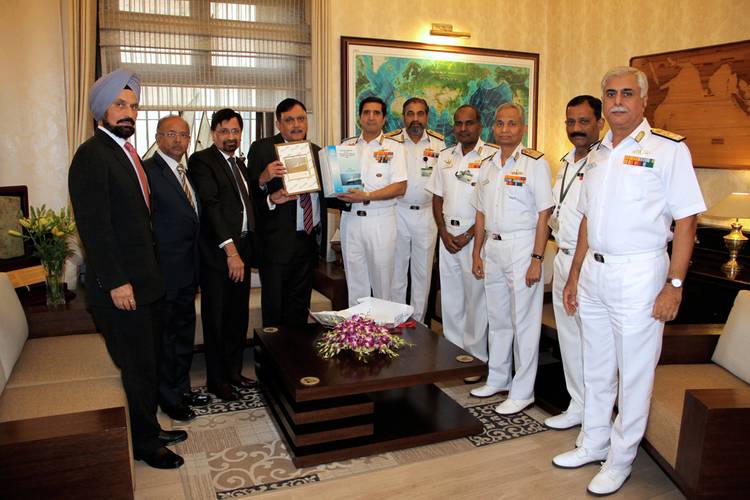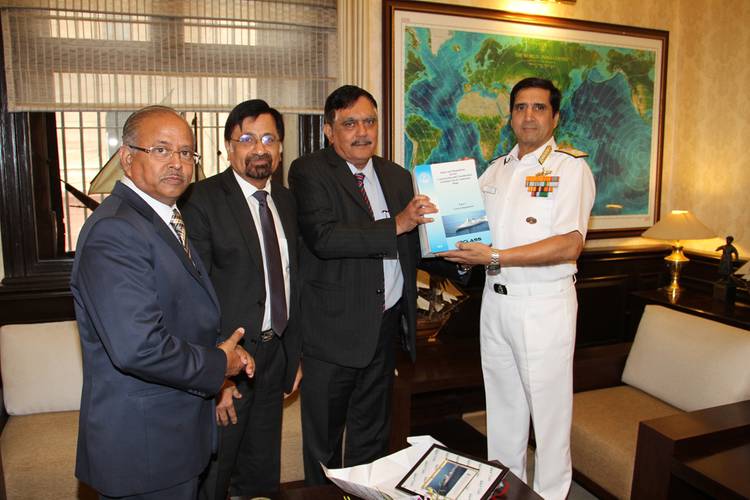IRClass Rules for Indian Naval Combatant ships released by Chief of the Naval Staff Admiral R K Dhowan
The “Rules and Regulations for Construction and Classification of Indian Naval Combatant Ships”, developed by Indian Register of Shipping were formally released by the Chief of the Naval Staff, Admiral RK Dhowan, PVSM, AVSM, YSM, ADC on June 9, 2015.
The release took place in South Block, New Delhi, in the presence of Vice Admiral P Murugesan AVSM, VSM, Vice Chief of Naval Staff, Vice Admiral AV Subhedar AVSM, VSM, Chief of Materiel, Vice Admiral GS Pabby AVSM, VSM, Controller of Warship Production and Acquisition and other senior officers of the Indian Navy. The Indian Register of Shipping was represented by Arun Sharma, Chairman and Managing Director, Vice Admiral B.S. Randhawa, PVSM, AVSM, VSM (Retd.), Principal Naval Advisor, U.S. Kalghatgi, Chief Surveyor and Senior Vice President, and Ravi Sachdeva, Chief Surveyor and Senior Vice President.
Traditionally, naval ships have been designed and built as per the navy’s own design standards. However, over the past two decades, advances in the commercial field have occurred, such as lightweight, high speed ships, with modern highly responsive propulsion plants etc., which have led to classification societies becoming capable of dealing with technology being deployed in naval ships. Some classification societies, in collaboration with national navies have developed special rules for naval ships which incorporate the best of commercial and naval practices and the usage of such rules has grown with time. Perceiving the substantial advantages to be gained in adopting specially developed naval rules, for building of naval ships, the Indian Navy and IRS joined hands to develop naval rules in 2006. A conservative approach was followed, and in the first instance, rules were drawn up for noncombatant vessels and not for major warships. These rules were first published in 2007 and were revised in 2010, in the light of experience gained in their usage. Following the release of rules for noncombatant vessels, the development of IRS Naval Rules for combatant vessels was taken up. These rules have greater focus on the military aspects of ship design.
This development marks a milestone in IRS’ history and is yet another contribution to make the nation, and more specifically so, the defense manufacturing sector, self-reliant. The Make-in-India initiative has been the raison d’etre of IRS’ existence which was established in 1975 with the active support of Ministry of Shipping to promote national maritime interests and serve as a nucleus for R&D in the shipbuilding and allied sectors.
A presentation on the salient features of the rules and on the process of development preceded the release. The release of rules marked the culmination of about four years of effort and Indian Navy has steadfastly stood by IRS in this endeavour, said Arun Sharma speaking on the occasion. He further spoke on the advantages inherent in having naval rules, which embody the best features of commercial and naval ship design features and production processes, leading to cost – effectiveness. He stated that IRS was looking forward to the rules being put into application in the near future and, in the process undergo further refinement and improvement. He also conveyed thanks to the naval officers in the Indian Naval Rule Committee, who, along with their subordinates, worked alongside IRS and provided invaluable guidance during the development process. The Chief of the Naval Staff congratulated IRS on the development of the rules and stated that it was necessary that the rules be implemented and continually reviewed and updated so as to remain abreast of contemporary technology.














